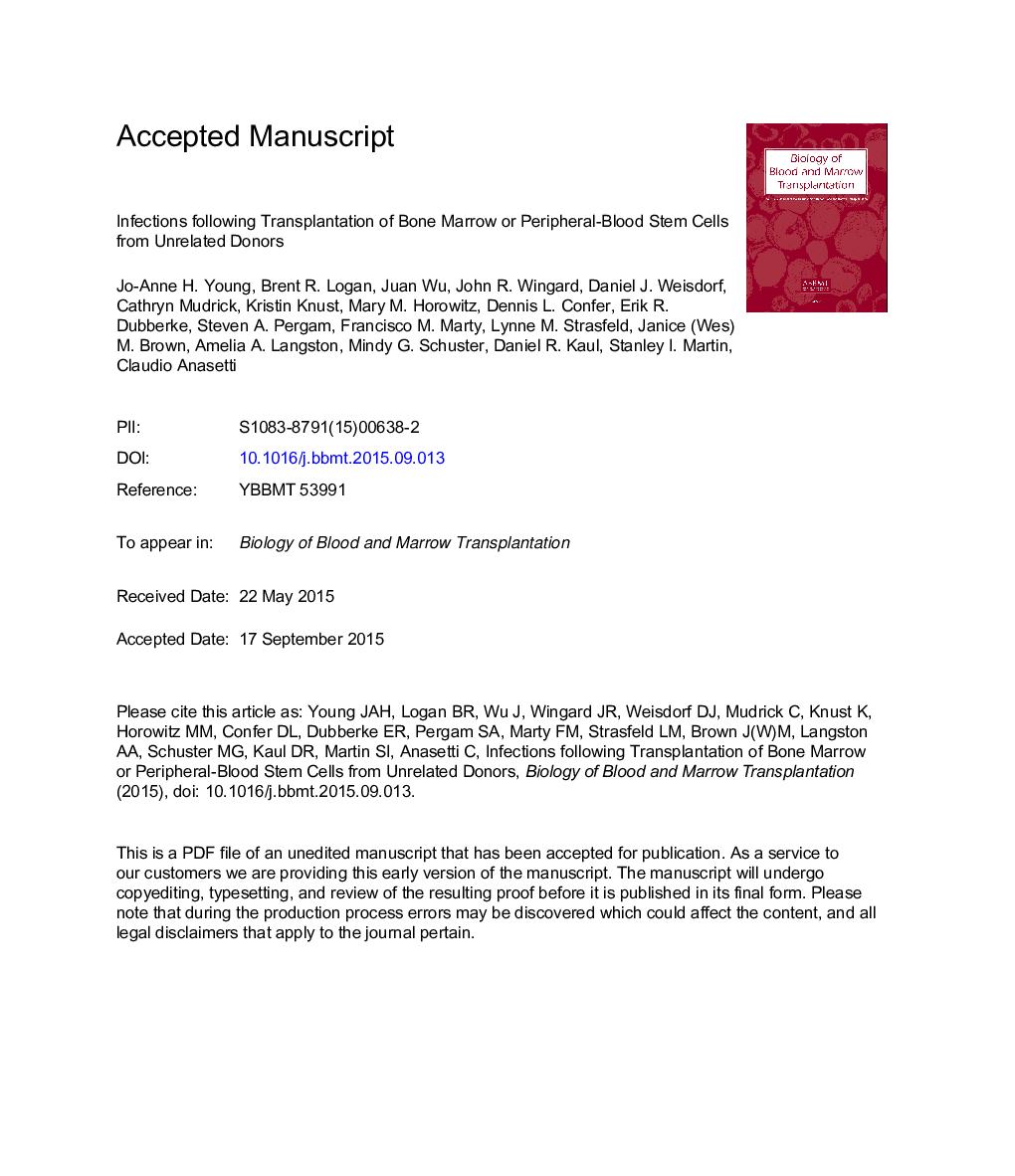| کد مقاله | کد نشریه | سال انتشار | مقاله انگلیسی | نسخه تمام متن |
|---|---|---|---|---|
| 8431201 | 1546258 | 2016 | 52 صفحه PDF | دانلود رایگان |
عنوان انگلیسی مقاله ISI
Infections after Transplantation of Bone Marrow or Peripheral Blood Stem Cells from Unrelated Donors
ترجمه فارسی عنوان
عفونت پس از پیوند مغز استخوان یا سلول های بنیادی خون محیطی از اهداکنندگان غیر مرتبط
دانلود مقاله + سفارش ترجمه
دانلود مقاله ISI انگلیسی
رایگان برای ایرانیان
کلمات کلیدی
عفونت، پیوند اهداکنندگان غیر مرتبط، باکتری، سیتومگالوویروس، آسپرژیلوز پیشگیرانه
موضوعات مرتبط
علوم زیستی و بیوفناوری
بیوشیمی، ژنتیک و زیست شناسی مولکولی
تحقیقات سرطان
چکیده انگلیسی
Infection is a major complication of hematopoietic cell transplantation. Prolonged neutropenia and graft-versus-host disease are the 2 major complications with an associated risk for infection, and these complications differ according to the graft source. A phase 3, multicenter, randomized trial (Blood and Marrow Transplant Clinical Trials Network [BMT CTN] 0201) of transplantation of bone marrow (BM) versus peripheral blood stem cells (PBSC) from unrelated donors showed no significant differences in 2-year survival between these graft sources. In an effort to provide data regarding whether BM or PBSC could be used as a preferential graft source for transplantation, we report a detailed analysis of the infectious complications for 2 years after transplantation from the BMT CTN 0201 trial. A total of 499 patients in this study had full audits of infection data. A total of 1347 infection episodes of moderate or greater severity were documented in 384 (77%) patients; 201 of 249 (81%) of the evaluable patients had received a BM graft and 183 of 250 (73%) had received a PBSC graft. Of 1347 infection episodes, 373 were severe and 123 were life-threatening and/or fatal; 710 (53%) of these episodes occurred on the BM arm and 637 (47%) on the PBSC arm, resulting in a 2-year cumulative incidence 84.7% (95% confidence interval [CI], 79.6 to 89.8) for BM versus 79.7% (95% CI, 73.9 to 85.5) for PBSC, P = .013. The majority of these episodes, 810 (60%), were due to bacteria, with a 2-year cumulative incidence of 72.1% and 62.9% in BM versus PBSC recipients, respectively (P = .003). The cumulative incidence of bloodstream bacterial infections during the first 100 days was 44.8% (95% CI, 38.5 to 51.1) for BM versus 35.0% (95% CI, 28.9 to 41.1) for PBSC (P = .027). The total infection density (number of infection events/100 patient days at risk) was .67 for BM and .60 for PBSC. The overall infection density for bacterial infections was .4 in both arms; for viral infections, it was .2 in both arms; and for fungal/parasitic infections, it was .04 and .05 for BM and PBSC, respectively. The cumulative incidence of infection before engraftment was 47.9% (95% CI, 41.5 to 53.9) for BM versus 32.8% (95% CI, 27.1 to 38.7) for PBSC (P = .002), possibly related to quicker neutrophil engraftment using PBSC. Infections remain frequent after unrelated donor hematopoietic cell transplantation, particularly after BM grafts.
ناشر
Database: Elsevier - ScienceDirect (ساینس دایرکت)
Journal: Biology of Blood and Marrow Transplantation - Volume 22, Issue 2, February 2016, Pages 359-370
Journal: Biology of Blood and Marrow Transplantation - Volume 22, Issue 2, February 2016, Pages 359-370
نویسندگان
Jo-Anne H. Young, Brent R. Logan, Juan Wu, John R. Wingard, Daniel J. Weisdorf, Cathryn Mudrick, Kristin Knust, Mary M. Horowitz, Dennis L. Confer, Erik R. Dubberke, Steven A. Pergam, Francisco M. Marty, Lynne M. Strasfeld, Janice (Wes) M. Brown,
